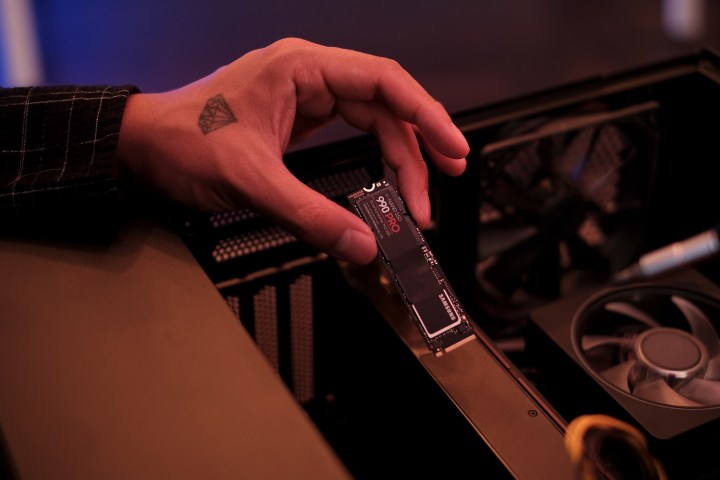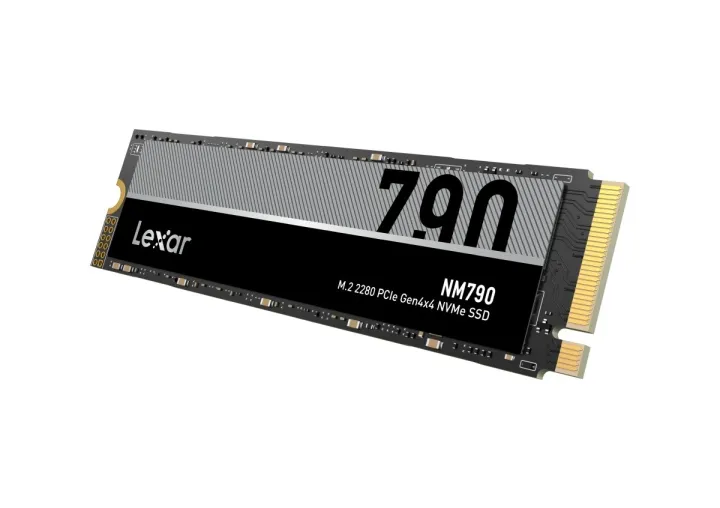These are the best NVMe SSDs to buy in 2024
The best and highly recommended NVMe SSDs that you should be putting your money on.

 Samsung
Samsung
Whether you are building a new gaming rig or planning to upgrade the existing storage on your PC, it makes sense to invest in one of the best solid-state drives (SSD) on the market. But if you are looking for the best performing storage with the fastest read and write speeds, then NVMe (Non-Volatile Memory Express) SSDs are the way to go.
What is NVMe? At a basic level, these drives offer up to 12 times faster speeds compared to SATA drives as well as offering better reliability and endurance. If you are planning to buy a new NVMe SSD then there are numerous options to choose from. To make things simpler, we have listed some of the best ones that you should be spending your money on.
 Crucial
Crucial
Crucial T705
Fastest PCIe Gen 5.0 NVMe SSD
Pros
Excellent speeds and performance Optional black/white heatsink AES 256-bit encryptionCons
Runs comparatively hotWhy should you buy this: One of the fastest NVMe SSDs on the market that doesn't cost a ton.
Who’s it for: Those who are looking for blistering-fast read and write speeds.
Why we picked the Crucial T705:
Building a new PC in 2024 means that you have the option of going beyond PCIe Gen 4.0 speeds. If you have invested in a newer motherboard and CPU combo that supports PCIe Gen 5.0, the Crucial T705 is worth considering. It is a top-tier PCIe 5.0 drive that delivers exceptional read and write speeds up to 13,600MBps and 10,200MBps, making it one of the fastest consumer SSDs on the market. It’s ideal for tasks demanding high performance, making it a great SSD for gaming and content creation, but it comes with the caveat of running hot, especially without a heatsink.
While the SSD did launch at a high price point, it is currently selling for $155 for the 1TB model and $185 if you want a heatsink. Overall, the Crucial T705 is a powerhouse in the SSD market, offering remarkable speed and reliability. But it’s essential to ensure proper cooling to maximize its performance, especially in systems without built-in heatsinks. This drive is best suited for those who prioritize speed and are willing to invest in high-end storage solutions.
Crucial T705
Fastest PCIe Gen 5.0 NVMe SSD
 Samsung
Samsung
Samsung 990 Pro
Fast and reliable Gen 4.0 NVMe SSD
Pros
Reliable and consistent performance Optional heatsink Samsung Magician software support Fastest PCIe Gen 4.0 SSDCons
More expensive than the competitionWhy should you buy this: All-round PCIe Gen 4.0 performance with AES 256-bit encryption.
Who’s it for: Professionals and gamers looking for the best performance out of their hardware.
Why we picked the Samsung 990 Pro:
Samsung has been a reliable name when it comes to flash storage, and the 990 Pro is the company’s flagship NVMe SSD offering. It is also our top recommendations for anyone looking for the fastest PCIe Gen 4.0 storage technology alongside 256-bit hardware encryption. The drive is claimed to deliver sequential read speeds of up to 7,450MBps and write speeds of up to 6,900MBps. Samsung claims that the 990 Pro uses less power with over 50% improved performance per watt over its predecessor, the 980 Pro.
Samsung also offers the SSD with a nickel-coated controller and improved thermal control algorithm to manage heat, while the optional heatsink can also be used to further dissipate heat effectively. Additionally, one can monitor the performance, including the health and temperature of the SSD, using Samsung's Magician software.
Samsung 990 Pro
Fast and reliable Gen 4.0 NVMe SSD
 Lexar
Lexar
Lexar NM790
Best performance at reasonable price
Pros
Great value for money Power efficient Great all-round performance High durability ratingCons
No hardware-based encryption No DRAM cacheWhy should you buy this: Best performing PCIe 4.0 NVMe SSD with a reasonable price tag.
Who’s it for: Professional users and gamers who are looking for the fastest read and write speeds.
Why we picked the Lexar NM790:
The Lexar NM790 SSD is a strong contender in the PCIe 4.0 market, offering impressive read and write speeds that make it suitable for a range of uses, from gaming to content creation. It provides solid performance at a very competitive price, making it an attractive option for those looking to upgrade their storage without breaking the bank.
However, the NM790 lacks DRAM, which may impact its performance in certain tasks, particularly when compared to higher-end drives with DRAM caches. Despite this, it still manages to hold its own in real-world applications, showing that it can handle demanding workloads efficiently. Overall, the Lexar NM790 is a well-rounded SSD that balances performance and affordability. It’s a good choice for users who need a reliable and fast SSD with fast PCIe Gen 4.0 speeds
Lexar NM790
Best performance at reasonable price
 Image used with permission by copyright holder
Image used with permission by copyright holder
Seagate Firecuda 530
Speedy NVMe SSD with high endurance
Pros
Highest endurance rating Fast sequential speeds Great all-round performanceCons
Not the most affordable Lacks hardware encryptionWhy should you buy this: Offers higher reliability and consistency with fast read and write capabilities.
Who’s it for: Gamers who are looking for a fast NVMe SSD that can sustain prolonged usage.
Why we picked the Seagate Firecuda 530:
The Seagate Firecuda 530 is another highly recommended NVMe SSD that offers one of the best endurance ratings on any NVMe SSD on the market. The base model with 500GB capacity comes with an endurance rating of 640 TBW, 1TB with 1275 TBW, 2TB with 2550 TBW, and there is also a 4TB storage option that can sustain 5100 TBW! To deal with high temperatures, Seagate offers an optional custom heatsink developed by EK Water Blocks (EKWB) to ensure maximum cooling efficiency thereby minimizing thermal throttling and enabling peak performance for longer periods of time.
Using a 176-layer 3D TLC NAND, the Firecuda 530 is claimed to offer the fastest speeds available on a PCIe Gen 4 NVMe SSD. It is said to reach sequential read speeds of up to 7,300MBps and write speeds of up to 6,900MBps. It is also one of the few NVMe SSDs on the market that is available with a maximum storage capacity of 4TB and as it is also fully compatible, it's a great SSD for the PlayStation 5. (If you were thinking about it, installing an SSD in your PS5 is pretty straightforward.)
Seagate Firecuda 530
Speedy NVMe SSD with high endurance
 Crucial
Crucial
Crucial P3
Affordable PCIe Gen 3.0 NVMe SSD
Pros
Well-priced Wide capacity options Five-year warrantyCons
No QLC or DRAM Low enduranceWhy should you buy this: Value NVMe SSD with PCIe Gen 3.0 interface.
Who’s it for: Casual gamers and media professionals who don't need PCIe Gen 4.0 speeds.
Why we picked the Crucial P3:
The Crucial P3 SSD is a budget-friendly NVMe drive that offers solid performance for its price range, making it an attractive option for users looking for a cost-effective storage upgrade. It's based on QLC NAND, which helps keep the price down, but also means it may not perform as well as higher-end TLC-based drives, particularly in write-intensive tasks.
In terms of speed, the P3 delivers competitive read and write speeds of 3,500MBps, making it suitable for general computing, gaming, and light content creation. However, it lacks DRAM, which can impact performance during heavy workloads or when the drive is nearly full. Despite this, it still manages to hold its own in everyday use, offering a good balance between performance and affordability.
One of the key strengths of the Crucial P3 is its value proposition. It provides decent performance at a lower cost compared to many other NVMe SSDs on the market, making it a great choice for budget-conscious users. The drive also comes with a five-year warranty, adding to its appeal as a reliable and affordable storage solution. Overall, the Crucial P3 is a solid entry-level NVMe SSD that offers good value for the price. While it may not be the fastest drive available, it's a great option for users who need a reliable SSD for everyday tasks or as a secondary storage drive.
Crucial P3
Affordable PCIe Gen 3.0 NVMe SSD
 Image used with permission by copyright holder
Image used with permission by copyright holder
ADATA XPG Spectrix S40G
For those who cannot live without RGB
Pros
Great 4K sequential-read capabilities Programmable RGB lighting AES 256-bit encryptionCons
Tends to run toasty Average endurance ratingWhy should you buy this: Affordable NVMe SSD with some RGB flair.
Who’s it for: Gamers and enthusiasts who care about RGB aesthetics.
Why we picked the ADATA XPG Spectrix S40G:
If you thought there weren't enough RGB products in the world, think again. ADATA's XPG Spectrix S40G is one of the few NVMe SSDs that comes with its own set of LEDs to add some RGB goodness to your system. Using the XPG RGB Software one with the S40G allows you to control the lighting on the drive. Apart from a customizable color palette, there are a variety of preset effects to choose from.
As for the performance, it is a PCIe Gen 3.0 NVMe SSD available in 256GB, 500GB, 1TB, and 2TB capacities. The maximum sequential read speeds are rated at 3,500MBps and sequential write speeds of 3,000MBps. ADATA claims that the 500GB model offers up to 320TBW which isn't the best when compared to the competition, hence it is best to go for the 1TB or the 2TB model which offer 640TBW and 1,280TBW respectively.
ADATA XPG Spectrix S40G
For those who cannot live without RGB
Frequently Asked Questions
What do you mean by NVMe?
NVMe or Non-Volatile Memory Host Express is the logical interface specification or the protocol that is used to access a computer’s non-volatile storage media at high speeds. In simpler words, it refers to the way in which data is moved instead of the size or the shape of the drive. NVMe delivers high-performance and is a highly scalable storage protocol, that has been designed for non-volatile memory media (NAND and Persistent Memory) directly connected to CPU via PCIe interface. Typical PCIe Gen 3.0 based NVMe SSDs can offer transfer speeds more than six times faster than SATA SSDs, while PCIe Gen 4.0 based SSDs can go over 12 times and the latest PCIe Gen 5.0 SSDs are about 25 percent faster.
Our comparison of NVMe, M.2, and SATA SSDs will clarify the differences.
What is PCIe?
PCIe is short for Peripheral Component Interconnect Express, which is a common serial expansion bus standard seen on most motherboards. The interface is used for connecting high-speed components to your PC like graphics cards, Wi-Fi cards, sound cards, and even SSDs. Depending on the number of bidirectional lanes that connect to them, PCIe slots come in different physical configurations: x1, x4, x8, x16, x32. The first generation of NVMe drives could fit into a standard PCIe motherboard slot similar to a graphics card, but today the modern NVMe drives use the M.2 form factor. NVMe drives with the M.2 form factor are like tiny sticks that measure a few inches long and around an inch wide.
At the moment there are five generations of PCIe - PCIe 1.0, PCIe 2.0, PCIe 3.0, PCIe 4.0 and PCIe 5.0. Naturally, if you are looking for the fastest data transfer speeds, it is recommended that you purchase NVMe SSDs that support PCIe 5.0 paired with a supporting motherboard and CPU. Having said that, PCIe 4.0 and even 3.0 are considerably fast for everyday computing.
What is M.2?
Apart from the 2.5-inch form factor, SSDs also come in a much smaller form factor called M.2. It is as small as a stick of gum and looks a lot like a tiny memory module. An M.2 SSD can be SATA-based, PCIe-based with NVMe, or PCIe-based without NVMe.
Do NVMe drives cost more?
Considering their fast speeds, NVMe drives can cost more than 2.5-inch SATA SSDs, but thanks to their wider adoption, the price difference is slowly fading away. For instance, a 1TB Samsung SATA SSD costs anything from $90 to $110. A similar capacity Samsung PCIe Gen 3.0 NVMe SSD or Gen 4.0 drive sells for the same price or even lower. If you are looking for the fastest speeds, prices for a 1TB PCIe Gen 5.0 NVMe SSD start anywhere from $130 to $140.

 Troov
Troov 






































